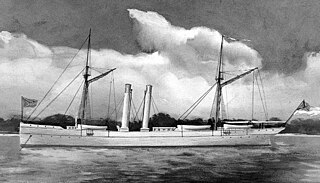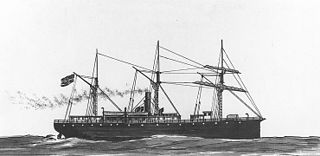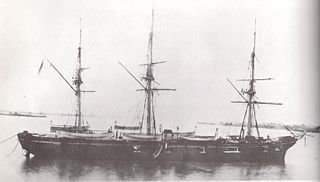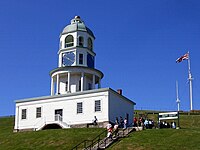
The Chesapeake Affair was an international diplomatic incident that occurred during the American Civil War. On December 7, 1863, Confederate sympathizers from the Maritime Provinces captured the American steamer Chesapeake off the coast of Cape Cod. The expedition was planned and led by Vernon Guyon Locke (1827–1890) of Nova Scotia and John Clibbon Brain (1840–1906). When George Wade of New Brunswick killed one of the American crew, the Confederacy claimed its first fatality in New England waters.

CSSEllis was a gunboat in the Confederate States Navy and the United States Navy during the American Civil War. It was lost during a raid while under command of famed Navy officer Lieutenant William B. Cushing.

CSSGeorgia was a screw steamer of the Confederate States Navy, acquired in 1863, and captured by the Union Navy in 1864.
CSS Raleigh was a steam-powered Civil War casemate ironclad. She was fitted with a spar torpedo instead of an iron ram and was built in 1863–1864 by the Confederate States Navy at Wilmington, North Carolina. While she was being built her commander was Lieutenant John Wilkinson (CSN). She was put into commission on April 30, 1864 under the command of Lieutenant J. Pembroke Jones, CSN.

CSS Robert E. Lee was a fast paddle-steamer, originally built as a Glasgow-Belfast packet boat named Giraffe, which was bought as a blockade runner for the Confederate States during the American Civil War, then subsequently served in the United States Navy as USS Fort Donelson and in the Chilean Navy as Concepción.

CSS Chickamauga, originally the blockade runner Edith, was purchased by the Confederate States Navy at Wilmington, North Carolina, in September 1864. In September, when she was nearly ready for sea, the Confederate Army sought unsuccessfully to retain her at that place for use as a troop and supply transport. On October 28, 1864, she put to sea under Lieutenant John Wilkinson (CSN) for a cruise north to the entrance of Long Island Sound, thence to St. George, Bermuda, for repairs and coal. She took several prizes before returning to Wilmington on November 19.

The third USS Montgomery was a wooden screw steamer in the Union Navy during the American Civil War.

CSS Sumter, converted from the 1859-built merchant steamer Habana, was the first steam cruiser of the Confederate States Navy during the American Civil War. She operated as a commerce raider in the Caribbean and in the Atlantic Ocean against Union merchant shipping between July and December 1861, taking eighteen prizes, but was trapped in Gibraltar by Union Navy warships. Decommissioned, she was sold in 1862 to the British office of a Confederate merchant and renamed Gibraltar, successfully running the Union blockade in 1863 and surviving the war.

The first USS Nereus, a screw steamer built at New York in 1863, was purchased by the Union Navy from William P. Williams on 5 October 1863; and commissioned at New York Navy Yard 19 April 1864, Commander John C. Howell in command.

USS Pontoosuc was a Union Navy vessel in the American Civil War. A side wheel gunboat, Pontoosuc was built under contract with G. W. Lawrence and the Portland Company, Portland, Maine, and was named for Pontoosuc, Illinois, on the Mississippi River. She was commissioned at Portland on 10 May 1864 with Lieutenant Commander George A. Stevens in command.

USS Yantic (IX-32), a wooden-hulled screw gunboat built at the Philadelphia Navy Yard, was launched on 19 March 1864 and commissioned on 12 August 1864, Lieutenant Commander Thomas C. Harris in command. She was named after the Yantic River.
USS Maumee was a steamer purchased by the Union Navy during the American Civil War. With her heavy guns, she was planned by the Union Navy for use as a bombardment gunboat, but also as a gunboat stationed off Confederate waterways to prevent their trading with foreign countries.

USS Vanderbilt was a heavy (3,360-ton) passenger steamship obtained by the Union Navy during the second year of the American Civil War and utilized as a cruiser.

USS Grand Gulf was a wooden-hulled, propeller-driven steamer acquired by the Union Navy during the American Civil War. She was effective in performing blockade duty, and captured a number of Confederate blockade runners.
USS Britannia was a steamer captured by the Union Navy during the American Civil War. She was used by the Union Navy as a gunboat and patrol vessel in support of the Union Navy blockade of Confederate waterways.

USS Ascutney was a large steamer with powerful guns acquired by the Union Navy during the American Civil War. She was used by the Union Navy as a gunboat in support of the Union Navy blockade of Confederate waterways. Post-war, she performed some steamship service for the Navy.

USS Shawmut was a 593-ton steamer acquired by the U.S. Navy and put to use by the Union during the American Civil War.

James Funk was a 19th-century New York City pilot boat built in 1862 at Greenpoint, Brooklyn for a company of New York Pilots. She was built for speed. She was assigned the "Number 22," which was displayed on her mainsail. The James Funk was captured and burned by the Confederate raiding steamer CSS Tallahassee during the American Civil War. The Charlotte Webb was built in 1865 to take the place of the James Funk that was destroyed.

The Adriatic was a three-masted, two deck, packet ship built in 1861 by Curtis & Tilden, Boston, Massachusetts, United States. On August 12, 1864, the Adriatic was embarked from London, England en route to New York City carrying 163 German immigrants and 100 US citizens. She made it as far as the New Jersey coast before meeting the Confederate raider CSS Tallahassee, that collided with her. Captain John Taylor Wood of Tallahassee ordered every passenger on the Adriatic to be taken prisoner and put on the Tallahassee. Wood then ordered the Adriatic to be burned.




















